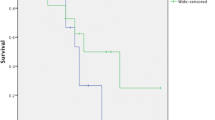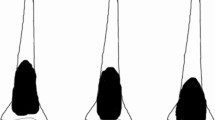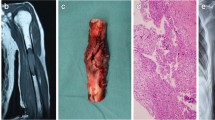Abstract
Limb-saving therapy for primary bone tumours is the treatment of choice. We aimed at analysing the quality of life of this group of patients by combining three different tools. Eighty-seven patients (46 females, 41 males) with a primary bone tumour of the extremity who had undergone endoprosthetic reconstruction between 1982 and 2000 were included in this retrospective study. The median age at the time of evaluation was 30 (12–73) years. The Toronto Extremity Salvage Score (TESS) and the Reintegration to Normal Living index (RNL) were recorded an average of 5.8 years after reconstruction and the Musculoskeletal Tumour Society Score (MSTS) after an average of 6.5 years. The mean MSTS score was 77% (13–93%). The mean TESS was 82% (22–99%), and the mean RNL index was 87% (32–98%). The subjective satisfaction and acceptance of physical impairment were significantly higher than the objective score (p < 0.001). The TESS was 88% in patients aged 12–25 years, 81% in those aged 26–40 years and 57% in those aged 41–73 years. Parallel recording of the MSTS score, TESS and RNL index provides a better measure reflecting the complex situation of the patients by combining objective and subjective parameters.
Résumé
La préservation du membre dans le traitement des tumeurs osseuses primitives des os doit être privilégiée. Le but de ce travail a été d’analyser la qualité de vie d’un groupe de patients dont le traitement a combiné différentes techniques. 87 patients (46 femmes et 41 hommes) présentant une tumeur primitive des extrémités osseuses et ayant bénéficié d’une endo prothèse entre 1982 et 2000 ont été inclus dans cette étude rétrospective. L’âge moyen au moment de l’évaluation des patients était de 30 ans (12 à 73 ans). Le score de Toronto ainsi que l’index RNL ont été utilisés en moyenne 5.8 ans après la reconstruction, de même que le score de la Société des Tumeurs Musculo-squeletiques. A à 6.5 ans en moyenne après le traitement. Le score MSTS moyen était de 77% (13 à 93%). Le score moyen TESS était de 82% (de 22 à 99%) et l’index RNL était de 87% (de 32 à 98%). La satisfaction des patients a été significativement plus élevée que l’évolution objective (p < 0.001). Le TESS était de 88% pour les patients âgés de 12 à 25 ans, de 81% chez les patients âgés de 26 à 40 ans et de 57% chez les patients plus âgés (de 41 à 73 ans). L’analyse des scores MSTS, TESS et de l’index RNL permet de mieux analyser les situations complexes de ces patients tant sur le plan objectif que subjectif.



Similar content being viewed by others
References
Cox DR, Snell EJ (1981) Applied statistics: Principles and examples. Chapman and Hall, London
Davis AM, Bell RS, Badley EM, Yoshida K, Williams JI (1999) Evaluating functional outcome in patients with lower extremity sarcoma. Clin Orthop 358:90–100
Davis AM, Devlin M, Griffin AM, Wunder JS, Bell RS (1999) Functional outcome in amputation versus limb sparing of patients with lower extremity sarcoma: a matched case-control study. Arch Phys Med Rehabil 80(6):615–618
Davis AM, Wright JG, Williams JI, Bombardier C, Griffin A, Bell RS (1996) Development of a measure of physical function for patients with bone and soft tissue sarcoma. Qual Life Res 5(5):508–516
Enneking WF, Dunham W, Gebhardt MC, Malawer M, Pritchard DJ (1993) A system for the functional evaluation of reconstructive procedures after surgical treatment of tumors of the musculoskeletal system. Clin Orthop 286:241–246
Fabroni RH, Castagno A, Aguilera AL, Steverlynck AM, Zeballos J (1999) Long term results of limb salvage with the Fabroni custom made endoprosthesis. Clin Orthop 358:41–52
Feinstein AR (1987) Clinimetric perspectives. J Chronic Dis 40(6):635–640
Gerrand CH, Currie D, Grigoris P, Reid R, Hamblen DL (1999) Prostetic reconstruction of the femur for primary bone sarcoma. Int Orthop 23(5):286–290
Hillmann A, Hoffmann C, Gosheger G, Krakau H, Winkelmann W (1999) Malignant tumor of the distal part of the femur or the proximal part of the tibia: endoprosthetic replacement of rotationplasty. Functional outcome and quality-of-life measurements. J Bone Joint Surg (Am) 81(4):462–468
Ilyas I, Pant R, Kurar A, Moreau P, Younge D (2002) Modular mega prosthesis for proximal femoral tumors. Int Orthop 26(3):170–173
Kawai A, Muschler GF, Lane JM, Otis JC, Healey JH (1998) Prosthetic knee replacement after resection of a malignant tumor of the distal part of the femur. Medium to long-term results. J Bone Joint Surg (Am) 80(5):636–647
Lindner NJ, Ramm O, Hillmann A, Roedl R, Gosheger G, Brinkschmidt C, Juergens H, Winkelmann W (1999) Limb salvage and outcome of osteosarcoma: The University of Muenster experience. Clin Orthop 358:83–89
Malo M, Davis AM, Wunder J, Masri BA, Bell RS, Isler MH, Turcotte RE (2001) Functional evaluation in distal femoral endoprosthetic replacement for bone sarcoma. Clin Orthop 389:173–180
McGoveran BM, Davis AM, Gross AE, Bell RS (1999) Evaluation of the allograft-prosthesis composite technique for proximal femoral reconstruction after resection of a primary bone tumor. Can J Surg 42(1):37–45
Natarajan MV, Annamalai K, Williams S, Selvaraj R, Rajagopal TS (2000) Limb salvage in distal tibial osteosarcoma using a custom mega prosthesis. Int Orthop 24(5):282–284
Ritschl P, Capanna R, Helwig U, Campanacci M, Kotz R (1992) KMFTR (Kotz Modular Femur Tibia Reconstruction System) modular tumor endoprosthesis system for the lower extremity. Z Orthop 130(4):290–293
Rompen JC, Ham JS, Halbertsma JP, van Horn JR (2002) Gait and function in patients with a femoral endoprosthesis after tumor resection: 18 patients evaluated 12 years after surgery. Acta Orthop Scand 73(4):439–446
Rougraff BT, Simon MA, Kneisl JS, Greenberg DB, Mankin HJ (1994) Limb salvage compared with amputation for osteosarcoma of the distal end of the femur. A long-term oncological, functional, and quality-of-life study. J Bone Joint Surg (Am) 76(5):649–656
Shin KH, Park HJ, Yoo JH, Hahn SB (2000) Reconstructive surgery in primary malignant and aggressive benign bone tumor of the proximal Humerus. Yonsei Med J 41(3):304–311
Tunn PU, Schmidt-Peter P, Pomraenke D, Hohenberger P (2004) Osteosarcoma in children - long-term functional analysis. Clin Orthop 421:212–217
Wittig JC, Bickels J, Kellar-Graney KL, Kim FH, Malawer MM (2002) Osteosarcoma of the proximal humerus: long-term results with limb-sparing surgery. Clin Orthop 397:156–176
Wood-Dauphinee S, Williams JI (1987) Reintegration to Normal Living as a proxy to quality of life. J Chronic Dis 40(6):491–502
World Health Organisation (1980) International classification of impairments, disabilities, and handicaps. Geneva
World Health Organisation (2002) Towards a common language for functioning, disability and health: The international classification of Functioning, Disability and Health (ICF) Geneva
Zahlten-Hinguranage A, Bernd L, Ewerbeck V, Sabo D (2004) Equal quality of life after limb-sparing or ablative surgery for lower extremity sarcomas. Br J Cancer 91(6):1012–1014
Author information
Authors and Affiliations
Corresponding author
Rights and permissions
About this article
Cite this article
Tunn, P.U., Pomraenke, D., Goerling, U. et al. Functional outcome after endoprosthetic limb-salvage therapy of primary bone tumours—a comparative analysis using the MSTS score, the TESS and the RNL index. International Orthopaedics (SICO 32, 619–625 (2008). https://doi.org/10.1007/s00264-007-0388-8
Received:
Revised:
Accepted:
Published:
Issue Date:
DOI: https://doi.org/10.1007/s00264-007-0388-8




